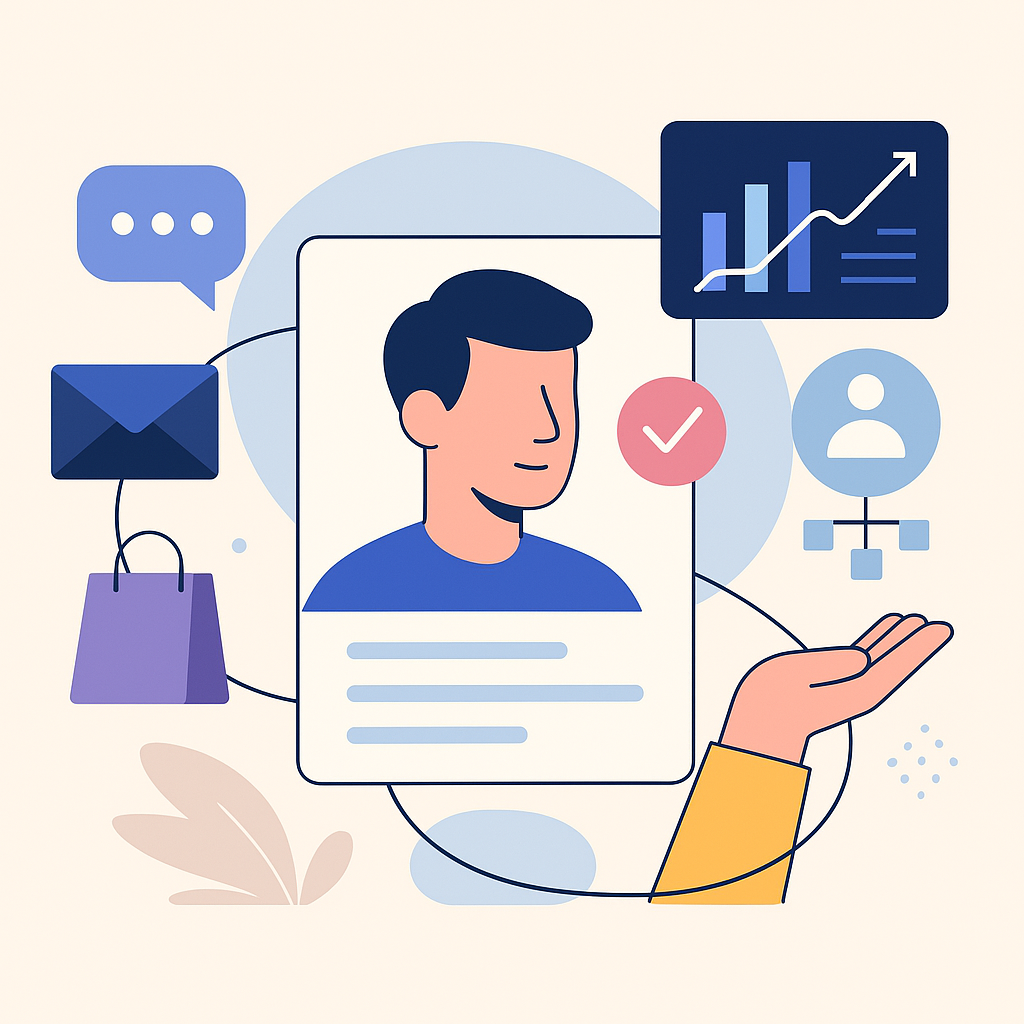By Suneha Singh
•
April 8, 2025
The digital world transformed today's customers need advertising content beyond generic materials. Customers today want brands to recognize their individual choices while forecasting their requirements for meaningful one-on-one communication. A Deloitte Digital study confirms that 75% of customers prefer buying products from brands which provide customized content. The message indicates that personalization sits at the core of present-day business requirements. Businesses must develop new methods for personalization because data privacy rules are becoming stricter and third-party cookies will no longer function. Customer experience advancement depends on using first-party data, AI insights, and automation systems that deliver human-like interactions. The following discussion outlines how companies should implement personalized methods to strengthen customer commitment and expand their operations. Why Personalization is the Foundation of Modern Marketing Personalization now functions as an essential industry requirement instead of giving companies an advantage against their competition. Multinational brands encounter consumer interactions daily, so those delivering highly relevant experiences create noticeable differences. Stronger Engagement –Investing in personalization leads businesses to achieve key benefits, including personalized engagement, which increases visitor duration on sites and boosts email response rates and social media conversational activity. Higher Conversion Rates —Specific content drives better sales results because customers show more significant responses, which drives higher ROI and conversion statistics. Customer Retention and Loyalty —Customer Loyalty and Retention are assisted through customized experiences that establish trust for extended relationships. Better Marketing Efficiency –Businesses gain higher marketing efficiency by strategically allocating their budgets based on identified customer preferences, reducing marketing costs. It is that consumers want genuine brand experiences, so businesses that cannot personalize their approach face competition from brands that deliver personalized engagements. How to Personalize Without Crossing the Line Customers accept personalized services while maintaining strong privacy requirements. When consumers experience excessive tracking or receive irrelevant recommendations, their trust in companies will suffer damage. Businesses should find the correct equilibrium between personal experiences and privacy protection through ethical data acquisition and transparent information dissemination. Here’s how: 1. First-Party Data: The Key to Meaningful Personalization Brands need to utilize first-party data as the ability to use third-party cookies decreases. First-party data includes consumer information from consumer engagement on websites, emails, and social media platforms. It provides better accuracy and reliability because it avoids the problems associated with third-party data methods. First-Party Data: How to Gather It (and Use It Right) With third-party cookies on the way out, first-party data is your best bet for creating meaningful personalization. Here's how to collect it the right way — and make it work for your brand: Offer Incentives for Sign-Ups: Encourage newsletter subscriptions by offering real value — think exclusive discounts, early product access, or members-only content. Use Surveys and Quizzes: Run quick, engaging quizzes or surveys to get direct insights into customer preferences and buying habits. Group Customers Intelligently: Use AI to segment users based on behavior, purchase history, and interaction patterns — so you can personalize at scale. Be Transparent and Respectful: Always explain how you’ll use customer data and make it easy for users to update preferences or opt out — trust is key. 2. Personalization in Email Marketing: Beyond First Names Email is still one of the best channels for delivering a personal touch, but simply tossing in a first name isn’t enough anymore. Today’s customers expect emails that reflect their interests, shopping behavior, and where they are in their journey. Let’s take a look at a quick Before vs. After to show what that looks like in action: Before (Minimal Personalization): Subject: Hey John, check out our new arrivals! Body: Hi John, We’ve just launched a new collection. Browse our latest products today. After (Deep Personalization): Subject: Still thinking about that navy blazer, John? Here's 10% off Body: Hi John, We noticed you were eyeing the navy slim-fit blazer last week — and we get it, it’s a classic. To help make your decision easier, here’s an exclusive 10% off. Plus, we've added a few shirt and shoe pairings we think you’ll love based on your past purchases. Offer ends in 48 hours! Smart Strategies for Effective Email Personalization Your emails should feel like they were written just for those receiving them. Here’s how to make that happen: Tailor Content by Audience Type: Show different content to new visitors compared to returning customers, whether it's product suggestions, offers, or brand stories. Trigger Emails Based on Behavior: Set up automated sequences that respond to real-time actions, such as abandoned carts, past purchases, or frequent browsing. Use AI to Predict Preferences: Let AI analyze behavior and purchase history to anticipate what customers might want next — and serve it up before they even ask. Personalize Subject Lines with Purpose: Go beyond “Hi [First Name]” — craft subject lines that reflect recent activity, interests, or urgency to boost open rates. 3. Website Personalization: Crafting Tailored User Journeys Websites utilize personalized methods to create customized customer experiences that lead clients through their journeys. Every business requires a digital storefront that serves as its website. A generic experience that remains unchanged no longer satisfies customers. Contemporary businesses must provide custom-made processes that effortlessly lead users from product discovery to final purchase. Here’s how to build a website that feels personal: Personalized Recommendations: Leverage AI-powered chatbots to suggest products or content based on a visitor’s browsing behavior or search queries. Dynamic Homepage Content: Use visitor data to serve up content that aligns with their interests — whether it’s showing products they’ve recently viewed or blog posts related to their last visit. Recently Viewed + Related Products: Display items that match a user’s past browsing history to keep their interests front and center. Geo-Targeted Offers: Tailor promotions and content by location — like highlighting free shipping for a specific region or featuring location-based services. 4. AI-Driven Personalization: Humanizing Automation AI technology and machine learning systems enable the scale of personalization interactions, though businesses must manage their systems to achieve efficiency through automation and create meaningful interactions with customers. All implementations of AI technology within companies should focus on enhancing human relations instead of seeking to replace human workers. Best Practices for AI-Driven Personalization AI can do a lot, but the magic happens when paired with a human touch. Use it to scale personalization while keeping your brand voice and authenticity intact. Here's how: AI + Human Oversight: Use AI tools to analyze data and automate personalized experiences, but always have humans in the loop to monitor output and ensure it aligns with real customer needs. Conversational Chatbots: Train AI chatbots to deliver helpful, human-like responses — no stiff, robotic replies. Think friendly guidance, not scripted responses. On-Brand AI Content: Ensure any AI-generated content matches your brand’s tone, style, and messaging. Personalization should feel seamless, not synthetic. 5. Hyper-Personalized Ads & Social Media Content The quantity of digital advertisements consumers encounter daily makes relevance the most essential factor for campaigns to stand out successfully. Customized advertising performs better regarding audience engagement and success outcomes than non-targeted marketing approaches. How to Personalize Digital Advertising and Social Media Content To break through the digital noise, your ads and social content need to be hyper-relevant. Here are smart ways to make them personal and powerful: Retarget Based on Behavior: Set up retargeting campaigns that respond to real actions, such as cart abandonment, product page views, or time spent on a specific service page. Audience Segmentation with AI: Use AI tools to segment your audience into smaller, behavior-based groups, so you can tailor messaging that speaks directly to each segment's needs. Leverage User-Generated Content (UGC): Share authentic customer photos, testimonials, and reviews to build trust and create community-driven engagement. Creative Backed by Real Data: Let audience preferences and live engagement metrics inform your ad copy, visuals, and call-to-actions, so your campaigns are always on target. Future Trends: What’s Next for Personalization? Personalization strategies will undergo new developments in the future. Technological development leads to the advancement of personalization methods. For business success, businesses need to adapt their strategies to new customer experience patterns that emerge. Several emerging patterns in personalization will determine how the practice unfolds in future years. AI-Powered Predictive Analytics: Through AI-powered predictive analytics, users will receive customized solutions that their future needs require while anticipating these needs ahead of time. Zero-Party Data Collection: Zero-Party Data Collection incentivizes customers to disclose personal preferences to receive personalized, valuable offers. Augmented Reality (AR) Personalization: Augmented Reality (AR) Personalization by the e-commerce sector for try-on features alongside interactive customer experiences will become standard practice. Conversational Commerce: Under conversational commerce, brands will utilize voice search, AI assistants, and messaging apps to initiate authentic real-time customer communications. Stronger Data Privacy Regulations: Organizations need to monitor evolving privacy rules since they play two roles: guaranteeing data protection and achieving successful personalization for their clients. Final Thoughts: Personalization as a Business Imperative Businesses must embrace personalization as an essential modification in their customer relationship approach instead of viewing it as a passing marketing technique. Brands implementing data-based personalization and privacy safeguards will establish exceptional customer ties, resulting in better sales and sustained client loyalty. Acorn to Oak Strategies helps businesses create customer-specific marketing solutions that merge automated procedures with human interaction. Our company assists businesses in achieving maximum customer-focused personalization through products that include personalized email campaigns, AI-enhanced website features, and data-based advertising options. Does your organization need to reshape its customer experience at present? Let’s make it personal.













